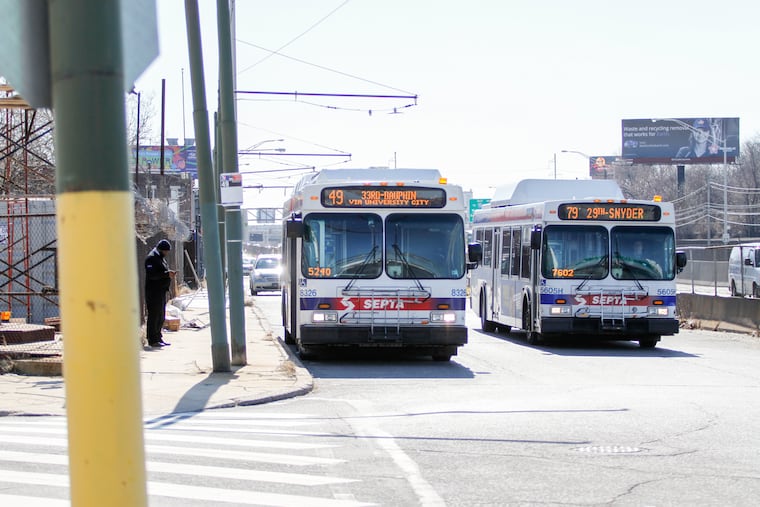‘I’m so excited about this’ — SEPTA’s newest bus route connects University City
It's starting out slowly, but SEPTA has high hopes for its newest bus route.

Riding SEPTA’s newest bus route on its first Monday felt like getting to a party, finding the room empty, and fearing no one else was going to show.
Inquirer photographer Margo Reed and I were the only people to board the Route 49 bus at a desolate corner in Point Breeze alongside the Schuylkill Expressway about 8:30 a.m. Monday, and as we traveled past closely packed rowhouses along 30th Street, we had the bus to ourselves. We took a goofy selfie. A fierce wind hurled plastic waste bins across empty streets.
The Route 49, three years in the making, began service Sunday to connect neighborhoods like Grays Ferry to the south and Brewerytown to the east with tourist attractions in Center City and the growing employment hub of University City. Buses run every 15 minutes at peak hours on weekdays and every 20 minutes during weekend midday hours.
>>READ MORE: SEPTA’s new bus route feeding University City to debut Sunday, spring schedules to take effect
The first passenger we saw Monday was a familiar face: Andrew Stober, a University City District vice president who’d lobbied mightily for SEPTA to create the service. He transferred to the bus at Dickinson Street from the Route 29. He glanced along the vacant bus. I jokingly asked him if he advocated for the $4.3 million new route to give himself a more convenient commute.
He reiterated the numbers that prompted SEPTA three years ago to begin planning for the service, its first new bus route in a decade. About 2,000 people live within a quarter-mile of the route between Point Breeze and Strawberry Mansion and work in University City. Up to now, their public transit options have stunk.
“For those folks, it was a three-seat ride to go two miles,” Stober said. “I would certainly encourage people to give it a try.”
In about 20 minutes, the bus traveled from residential Philly to the collegiate vibe and bustling construction of University City. All those new buildings mean new workers, and SEPTA is betting that they’ll use the new bus. Stober predicted it would take three months for the new route to catch on. That matches SEPTA’s estimate. The agency anticipates ridership will grow substantially in the spring, said Andrew Busch, a SEPTA spokesman.
“In general, whenever we launch a new service, it does take some time for customers to learn about it and get acclimated to it,” he said.
SEPTA is predicting 3,000 riders a day will become the norm within the next year.
Children’s Hospital of Philadelphia, the universities, Amtrak, the IRS — University City has a few institutions that employ a lot of people, and the University City District plans to distribute fliers through those businesses to employees who might benefit from the bus. SEPTA, meanwhile, plans to give community groups and businesses in the neighborhoods served schedules and brochures, and will have digital ads on the Market-Frankford and Broad Street subway lines, and on other buses.
>>READ MORE: Here’s what went into creating Philly’s first new bus route in almost a decade
At 33rd and Chestnut Streets, the first passenger who didn’t have a hand in creating the route got on board.
“I’m going to ride it because I want them to keep it,” said Elisa McCool, 35, an English professor at Community College of Philadelphia.
She lives in West Philadelphia and took the 42 bus to connect with the new bus route. She’s hopeful it will be a viable option for getting to work.
“It’s nice to have a route that’s a little more direct,” she said.
The Franklin Institute and 30th Street Station loomed through the bus windows. Lisa Rodrigues, 41, got on, heading home to Fairmount after buying groceries.
She wouldn’t need the bus to get to work at Villanova, she said, but would probably use it to travel to 30th Street Station.
“It fills a gap that was there,” she said.
The bus goes as far as Strawberry Mansion on its roughly seven-mile route, but Margo and I got off at the Philadelphia Museum of Art’s Perelman Building. We grabbed coffees at Little Pete’s in the Philadelphian apartment building because it was freezing, then boarded a bus going the other way. This time, five or six people were on board, sharing a giddy camaraderie over being among the first to discover something new.
“I’m so excited about this, actually,” beamed Yian Ko, 33, a researcher at the Perelman Center for Advanced Medicine, part of Penn Medicine.
She’s been using Uber to get to work for months, SEPTA’s worst nightmare. The transit agency has been losing riders and attributes the loss, in part, to the proliferation of ride sharing in the city. If Ko takes an Uber Express Pool, the price is competitive with SEPTA’s $2.50 fare, she said, but she was excited about switching to the bus.
“I’ve been spreading the news everywhere to my friends,” she said.
In the seats behind her, two women greeted each other warmly. Ko turned around, and they shared their enthusiasm about the new transit option.
Ko started working at 6 a.m. from home, and most important to her was making her commute the most efficient possible. She wanted to give the 49 a week’s trial run to decide whether it would be a better option than Uber.
“Time will be the key,” she said, “price will be the second, and consistency the third.”